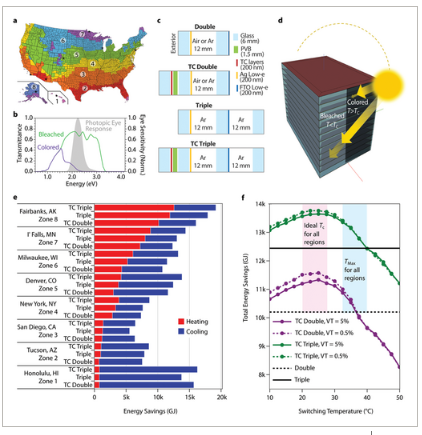NREL、ビルの省エネに理想的なペロブスカイト型技術の計算と製造に成功 NREL Calculates and Fabricates Perovskite-Based Technology With Ideal Transition Temperatures for Building Energy Savings
2023-02-09 米国国立再生可能エネルギー研究所(NREL)
◆太陽エネルギーを吸収するペロブスカイト材料を用いたサーモクロミック窓は、透明な状態から目に見える形で吸収または反射する状態に変化します。この技術により、温暖な地域では暖房負荷を軽減し、寒冷な地域では冷房負荷を軽減することができます。
◆このプロジェクトの主任研究員であるLance Wheelerは、サーモクロミック窓に切り替えることで、年間かなりのエネルギーを節約することができると述べています。また、シミュレーションしたオフィスビルの従業員全員が、アメリカ人の平均的な通勤距離に合わせて電気自動車を運転した場合、年間を通じて毎日、従業員全員の車をフル充電できるエネルギー量になるそうです。
◆この成果は、『Advanced Energy Materials』誌に掲載された論文に詳述されています。NRELからの共著者は、Bryan Rosales, Janghyun Kim, Kevin Prince, Mirzo Mirzokarimov, Tom Daligault, Adam Duell, Colin Wolden, and Laura Schelhasです。他の共著者は、コロラド鉱山学校、ウィスコンシン大学スタウト校、スイフトソーラー社です。
◆研究チームは、窓と壁の比率が95%の12階建ての建物をモデルとして使用しました。ハワイ、アリゾナ、カリフォルニア、コロラド、ニューヨーク、ウィスコンシン、ミネソタ、アラスカの8つの気候帯で、この建物のエネルギー使用量を15分間隔で1年間シミュレーションしたところ、次のような結果が得られました。彼らは判断しました。
・サーモクロミック二重窓は、各ゾーンにおいて、二重窓よりも建物のエネルギー効率を向上させた。
・寒冷地では、より大きなエネルギー節約効果があった。
・サーモクロミックダブルペイン窓は、最も暑い地域ではトリプルペイン窓よりも優れていた。
◆研究者は、寒冷地ではトリプルペイン窓の方がサーモクロミック二重窓よりも省エネ効果が高いが、サーモクロミックラミネートを追加してトリプルペイン窓にすると、最高効率のダブルペイン窓に比べ最も年間エネルギーが節約できると述べています。
◆サーモクロミック窓は温度によって変化しますが、研究者は理想的な転移温度は摂氏20〜27.5度(華氏68〜81.5度)の範囲に収まることを計算しました。
◆研究者たちは、モデリングを実験と結びつけ、ペロブスカイト膜を2層のガラスの間に挟み込んで実証しました。サーモクロミック・スイッチングは、200サイクルの耐久性があることが証明されました。
<関連情報>
- https://www.nrel.gov/news/press/2023/news-release-perovskite-based-themochromic-windows-reduce-energy-load-and-carbon-emission-in-buildings.html
- https://onlinelibrary.wiley.com/doi/10.1002/aenm.202203331
理想的な転移温度を持つサーモクロミックハライドペロブスカイトウィンドウ Thermochromic Halide Perovksite Windows with Ideal Transition Temperatures
Bryan A. Rosales, Janghyun Kim, Vincent M. Wheeler, Laura E. Crowe, Kevin J. Prince, Mirzo Mirzokarimov, Tom Daligault, Adam Duell, Colin A. Wolden, Laura T. Schelhas, Lance M. Wheeler
Advanced Energy Materials Published: 06 February 2023
DOI:https://doi.org/10.1002/aenm.202203331

Abstract
Urban centers across the globe are responsible for a significant fraction of energy consumption and CO2 emission. As urban centers continue to grow, the popularity of glass as cladding material in urban buildings is an alarming trend. Dynamic windows reduce heating and cooling loads in buildings by passive heating in cold seasons and mitigating solar heat gain in hot seasons. Here, reduced energy consumption in highly glazed buildings in a mesoscopic building energy model is demonstrated when thermochromic windows are employed. Savings are realized across eight disparate climate zones of the United States. The model is used to determine ideal critical transition temperatures of 20–27.5 °C for thermochromic windows based on metal halide perovskite materials. Ideal transition temperatures are realized experimentally in composite metal halide perovskite films composed of perovskite crystals and an adjacent reservoir phase. The transition temperature is controlled by cointercalating methanol, instead of water, with methylammonium iodide and tailoring the hydrogen-bonding chemistry of the reservoir phase. Thermochromic windows based on metal halide perovskites represent a clear opportunity to mitigate the effects of energy-hungry buildings.



